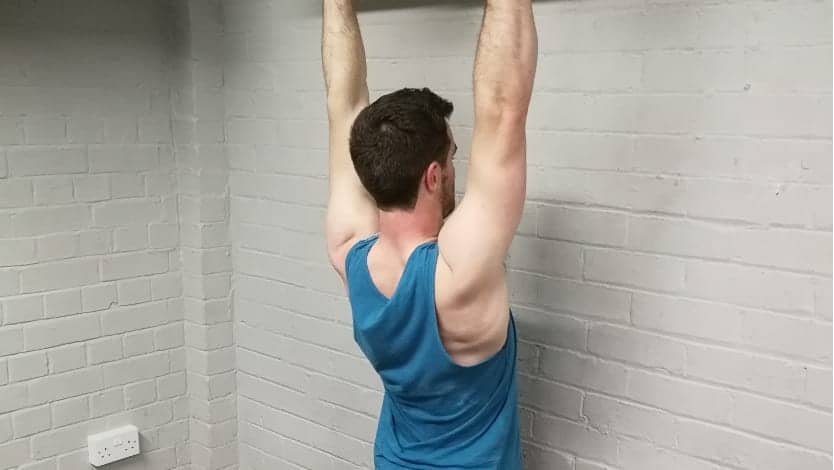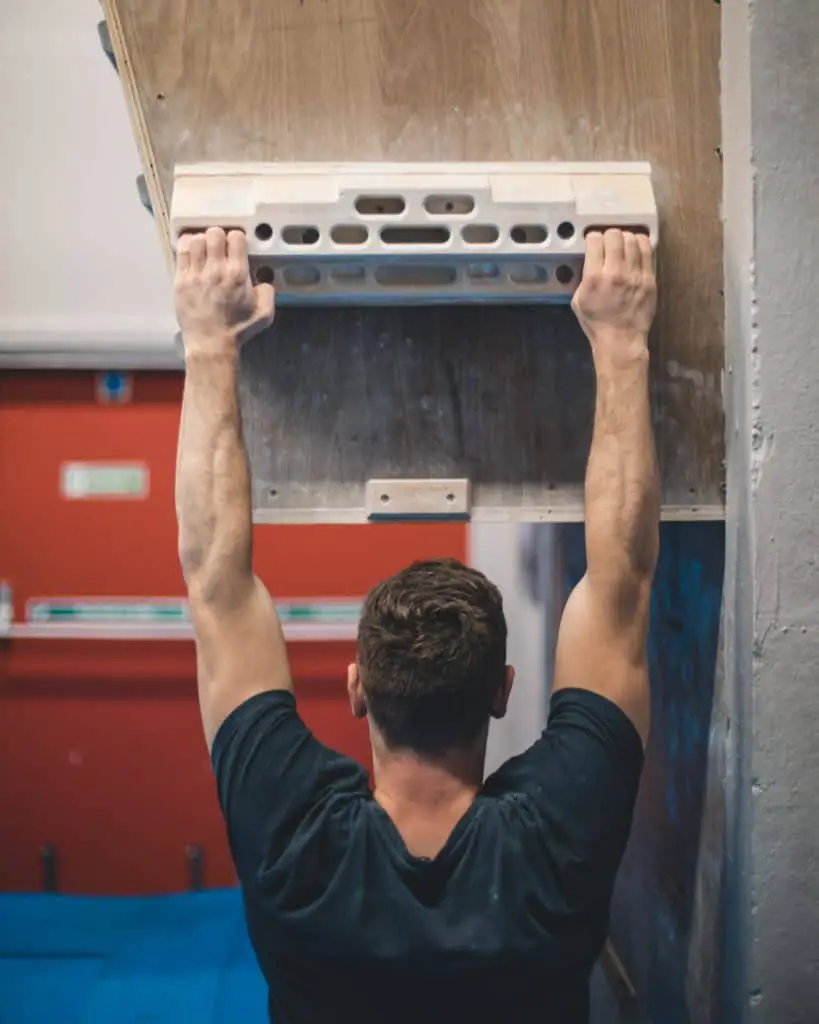
Before I was a climber I trained Brazilian Jiu Jitsu which is a grappling martial art. I had to give that up due to quite a horrible neck injury that still haunts me to this day. I used to get rotator cuff injuries a lot, so when I moved onto climbing I wondered if it could affect the shoulder area in a positive or negative way. I went on to do a lot of research surrounding this subject and over the last few years of climbing I’ve seen what has happened to my shoulders. I’ve also got a few good tips to help prevent and heal shoulder injuries.
So, is rock climbing bad for your shoulders? Rock climbing can be bad for your shoulders if you severely injure them or don’t take the right measurements to strengthen them in order to prevent injuries. There are many climbers who experience shoulder injuries throughout their climbing “career”, but they then haven’t taken the proper care to prevent them from happening in the first place or promote the healing of the injury afterwards. The most common types of shoulder injuries for a climber are:
- Tendonitis
- Subluxation (also known as a Part-Dislocation)
- Rotator cuff tear
- Shoulder impingement
These can be very painful and annoying when climbing, but as we have mentioned there are ways to limit the chance of these injuries from occurring and help their rehabilitation if they do.
So let’s take a look at the injuries listed above, what they are, how to prevent them and how to help those injuries heal.
Page Jumps
The Most Common Shoulder Injuries
Shoulder injuries are quite common in climbing if actions aren’t taken to prevent them. Let’s have look at the most common shoulder injuries, their symptoms, whether they have trouble fully healing, and how we can prevent them from happening.
Tendonitis
What is tendonitis?
Tendonitis is when a tendon is severely inflamed, usually because the tendon has been overused. It can also be caused by an infection or rheumatic disease. There is a very common type of tendonitis in the shoulder known as Pitcher’s Shoulder.
Pitcher’s shoulder is usually treated with rest and rehabilitation and if severe can take weeks or even months to heal. It is a problem of the rotator cuff of the shoulder which is a group of 4 muscles that help the shoulder to move. The pain is caused by the tendons compressing as they pass through the shoulder joint and gradually becoming inflamed and weak.
In climbing, tendonitis is obviously caused by overuse of the tendon because of how often we use our shoulder muscles to pull our body up. This can sometimes be because some climbers use upper body strength over using proper technique which can result in injury. It can also be because constantly climbing affects the tendons in your shoulder due to overuse.
Symptoms of tendonitis
- Shoulder is tender
- Small amount of swelling due to inflammation
- Dull ache especially if moving the shoulder
- Sometimes will hear a click or snapping in the shoulder when moving it
Can tendonitis be a permanent condition if left untreated?
If you keep climbing on an injury which relies on rest and rehabilitation such as this, it can affect you a lot in the future. Surgery can be an option to repair the problem if rest and rehabilitation isn’t working.
How is it prevented?
Stretch your shoulders before and after any workout that involves their use – including climbing. You should also consider strengthening your shoulders either by using weights or calisthenics. Improving your technique means lowering your need to over-use your muscles. Instead of using your muscles too much, try to climb up the wall mainly with technique.
Subluxation (also known as a Part-Dislocation)
What is subluxation?
Subluxation is a partial or incomplete dislocation. When it comes to the shoulder, what this means in layman’s terms is that the ball joint in your shoulder partially popped out. Sometimes it can then return to its original place on its own.
In climbing, subluxation is usually caused by dynamic (dyno) moves or other maneuvers that require you to “hold on for dear life”.
Symptoms of subluxation
- Pain in shoulder
- Range of movement is limited
- Acromion and humeral head are separated by a large gap
- Swelling
- Parasthesia (pins and needles) in your arm
Can subluxation be a permanent condition if left untreated?
If subluxation occurs often in someone then they’ll probably require surgery for it to heal properly. If you’ve had a subluxation injury but you don’t get them repeatedly then it can take a few weeks of immobilizing the shoulder in a sling before it heals.
How is it prevented?
You can prevent subfluxation from happening by being less aggressive on the climbing wall. If you force yourself up a wall by attacking holds, you have more chance of obtaining a partial dislocation.
Rotator Cuff Tear
What is a rotator cuff tear?
As we’ve already said when talking about pitcher’s shoulder, the rotator cuff is a group of 4 muscles within the shoulder that bind together as tendons. These muscles are called:
- Infraspinatus
- Supraspinatus
- Subscapularis
- Teres minor
They cover the head on the humerus bone on the upper arm. When a rotator cuff tears, it can be because of a fall, or if the shoulder is maneuvered in an aggressive manor such as pulling to hard on a hold when climbing. It can also be caused by general wear and tear due to ageing.
Symptoms of a rotator cuff tear
- Pain at front of the shoulder that carries on down the side of the arm
- May feel pain when sleeping on the same side
- Weakness of the arm
- Snapping/clicking sensation may occur
Can a rotator cuff tear be a permanent condition if left untreated?
Rotator cuff tears usually heal within six months if proper rehabilitation methods are used. If left untreated or if you were to train whilst the injury was still present, the rotator cuff tear could either get worse, reoccur, or it won’t heal. More serious rotator cuff tears may require surgery, but this isn’t always the case. Rehabilitation through physiotherapy and/or doing certain other exercises is very important if you’d like a rotator cuff to heal fully.
How is it prevented?
To prevent rotator cuff tears you should strengthen the rotator cuff. There are a few, easy exercises that can be done with a resistance band and/or small dumbbells that can be done at home while you doing something else like watching the television. I’ve listed these exercises below using dumbbells as the primary equipment used; however a resistance band can be substituted. These exercises are:
- External Rotation using the dumbbells
- Internal Rotation using the dumbbells
- Shoulder abduction using the dumbbells
- Shoulder raises also known as forward raises
Shoulder Impingement
What is a shoulder impingement?
A shoulder impingement is also known as swimmer’s shoulder. Swimmer’s shoulder is when your rotator cuff catches or rubs against the acromion – which is the outer edge of the shoulder blade. There is a natural space between the rotator cuff and the acromion within your shoulder – this is called the bursa. As you lift your arm, the bursa becomes smaller and your rotator cuff can become caught inside it. Over time your rotator cuff becomes irritated by the rubbing and catching of the acromion. This leads to a shoulder impingement.
Symptoms of a shoulder impingement
- Mild but ongoing pain in the arm and shoulder
- Pain that varies between the front of the shoulder and the side of the arm
- Pain can get worse at night
- Weakness in the shoulder and/or arm
Can a shoulder impingement be a permanent condition if left untreated?
If left untreated and the impingement is still trained on, the injury can become worse or it just won’t heal. Rest is crucial for healing. Avoid performing any exercises where severe pain occurs. Don’t use a sling or anything similar to immobilize the arm as this can make your shoulder stiff and lead to your arm becoming even weaker. Using an ice pack for around 15 minutes at a time a few times a day can promote healing, reduce swelling, reduce inflammation, and reduce pain. Surgery is usually not required unless the impingement becomes a severe rotator cuff tear. Physiotherapy is a successful way to treat a shoulder impingement.
How is it prevented?
Prevent shoulder impingements by using proper posture in your day to day activities – no slouching, shoulder blades back and head up. Shoulder impingements also happen when you aren’t doing an activity correctly. Make sure you’re climbing with technique rather than using massive amounts of upper body strength.
How to Heal Shoulder Injuries
After reading the book by Dr. John M. Kirsch, MD called Shoulder Pain: The Solution & Prevention, there’s a lot of evidence that points to one simple method which helps eradicate most shoulder problems. Kirsch is a former orthopaedic surgeon who found – after doing many studies on his patients – that almost every type of shoulder ailment can be cured by performing a Brachial Hang. A brachial hang is a shoulder width hang on a pull-up bar with the palms facing forward using a “monkey grip” on the bar. Let your shoulders fully relax. A brachial hang can also be done on a fingerboard. Perform this for at least 20 seconds at a time, or several minutes if possible.

The more you do this throughout the day, not only will you see a reduction in shoulder pain, but you will promote healing in your shoulder. By doing this you’re letting the humerus bone slightly come out of its socket and you’re giving it more of ability to move. After finding this out, Kirsch stopped doing surgery on shoulders and instead has started promoting this method as the number 1 way to heal most shoulder problems!
Related Questions
Is rock climbing good for posture? Rock climbing can be good for posture due to the fact it uses core strength. If you also perform exercises to compliment rock climbing such as the brachial hang technique, this can also improve overall posture.
How do you get rid of a pulled muscle in your shoulder? You should rest your shoulder and perform exercises to help rehabilitate your shoulder. Only perform exercises on your shoulder that promote healing such as the brachial hang technique and the sitting shoulder stretch. Ice is also great to encourage your pulled shoulder muscle to heal.
